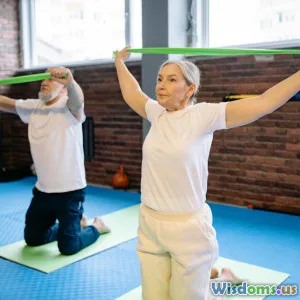
Top 7 Plyometric Exercises That Boost Soccer Players Jump Height
9 min read Discover the top 7 plyometric exercises proven to increase soccer players' jump height and explosive power effectively. (0 Reviews)
Top 7 Plyometric Exercises That Boost Soccer Players' Jump Height
Introduction
In soccer, explosiveness isn't just an asset—it's often the difference between a game-winning header and a missed opportunity. Vertical jump ability plays a pivotal role for players aiming to dominate aerial duels, intercept long balls, and execute game-changing headers. But how can players effectively train to enhance their jump height? Plyometric training offers an evidence-based solution that directly targets the neuromuscular systems responsible for explosive movement.
Plyometrics, or “jump training,” involves exercises that enable muscles to exert maximum force in short intervals of time, boosting power and jump performance. Coaches and athletes alike swear by plyometric training to develop not only vertical leap but also overall agility and speed. This article delves into the seven most outstanding plyometric exercises designed to elevate jump height, supported by research and practical examples for soccer players.
Why Plyometric Training is Essential for Soccer Players
The sport demands rapid force generation, outstanding coordination, and powerful lower-body dynamics. Plyometrics activate the stretch-shortening cycle—where a muscle rapidly lengthens (eccentric phase) before contracting (concentric phase)—building explosive strength.
Research shows that plyometric training results in significant improvements in vertical jump height. For instance, a 2010 study published in the Journal of Strength and Conditioning Research found that soccer players who underwent an 8-week plyometric program improved their vertical jump by up to 12%. Such gains can translate directly to winning headers and winning games.
According to FIFA-certified strength coach John Guzman, "Incorporating plyometrics into a soccer training regimen is essential for players who want to be competitive in aerial duels. Beyond vertical jump, it enhances overall speed and reduces injury risk through improved muscle elasticity."
The Top 7 Plyometric Exercises to Boost Jump Height
1. Depth Jumps
Description: Depth jumps develop reactive strength and explosiveness by using gravity to overload the stretch-shortening cycle.
How to perform:
- Begin by standing on a sturdy box (18-24 inches high).
- Step off the box and land softly on the balls of your feet.
- Upon landing, immediately jump as high as possible.
Benefits: Depth jumps increase reactive power by training the muscles’ rapid switch from eccentric to concentric contractions. This exercise has been shown to increase vertical jump height by enhancing tendon stiffness and muscle responsiveness.
Practical tip: Start with lower boxes to prevent injury and gradually increase height as you develop control.
2. Bounding
Description: Bounding involves long, exaggerated strides to train single-leg explosive power and improve horizontal and vertical force application.
How to perform:
- Run forward while pushing off one foot powerfully to cover maximum ground.
- Emphasize height and distance with each bound.
- Perform over a distance of 20–30 meters for 3–4 sets.
Benefits: Bounding mimics the sprinting and jumping motions used in soccer, making it functional and transferable. It increases stride length and power.
Scientific insight: A study from the University of Southern Queensland suggests bounding improves lower limb power and proprioception, essential components in jump height.
3. Box Jumps
Description: Box jumps develop explosive leg power by jumping onto a raised platform with maximum force.
How to perform:
- Stand facing a box or sturdy platform 12-30 inches high.
- Jump explosively using both legs, landing softly with knees bent.
- Step down carefully and repeat.
Benefits: Simple yet effective, box jumps recruit fast-twitch muscle fibers which are critical for vertical leap improvements.
Coaching cue: Focus on a soft and controlled landing to absorb impact and train eccentric strength.
4. Tuck Jumps
Description: Tuck jumps are fast repetitions of vertical jumps where knees are brought towards the chest to train rapid hip flexion.
How to perform:
- Jump upward explosively.
- While airborne, tuck knees toward your chest.
- Land softly and immediately repeat.
Benefits: Tuck jumps improve explosive strength and knee drive, two critical components for jumping higher.
Real-world usage: Elite soccer training programs regularly include tuck jumps for neuromuscular conditioning.
5. Single-Leg Hops
Description: This exercise targets unilateral leg power and balance by performing repeated hops on one leg.
How to perform:
- Hop forward on one leg over short distances (5-10 meters).
- Focus on landing quietly and maintaining balance.
- Alternate legs for balanced strength.
Benefits: Single-leg hops reduce asymmetry between limbs and build stability, essential to prevent injuries and improve jumping mechanics.
Supporting fact: According to the American Council on Exercise, unilateral plyometrics help address muscular imbalances often observed in soccer players.
6. Broad Jumps (Standing Long Jumps)
Description: Broad jumps emphasize horizontal explosiveness, which correlates with vertical jumping ability.
How to perform:
- Stand with feet shoulder-width apart.
- Swing arms and bend knees to explode forward as far as possible.
- Land with bent knees to absorb impact.
Benefits: Enhances power, coordination, and overall muscle recruitment in the lower body.
Example: Many professional soccer conditioning drills incorporate broad jumps as a standard test of elite athleticism.
7. Lateral Skater Jumps
Description: Skater jumps improve lateral explosiveness and strengthen stabilizer muscles, complementing vertical jump training.
How to perform:
- Leap sideways from one foot to the other.
- Try to cover as much horizontal distance as possible.
- Control landing and balance.
Benefits: Lateral movement is critical in soccer; this drill enhances agility, power, and jump control in multiple planes.
Insight: Incorporating multidirectional plyometrics improves overall athleticism, critical outside vertical jump height alone.
Structuring Your Plyometric Training Program
To maximize the benefits of these exercises, integrate plyometric training into your weekly routine 2–3 times per week. Prioritize quality over quantity to prevent injury:
- Warm up extensively before sessions.
- Begin with lower intensity drills and gradually progress.
- Combine plyometrics with strength training for synergistic effects.
- Allow sufficient recovery to avoid overtraining.
Elite soccer teams, such as those in the English Premier League, carefully periodize plyometric work within their training cycles, balancing recovery and intensity for peak performance.
Closing Thoughts
Jump height is a crucial determinant of a soccer player’s effectiveness during aerial contests, defensive clearances, and attacking headers. Plyometric training offers a research-backed, dynamic way to sharply increase this ability through muscle power and neurological adaptation.
The seven exercises highlighted—depth jumps, bounding, box jumps, tuck jumps, single-leg hops, broad jumps, and lateral skater jumps—are proven, actionable drills that can enhance your vertical leap, agility, and overall soccer performance.
Remember, consistency and correct technique cement gains over time. Begin incorporating these movements into your regimen today, and watch your leap (and game) reach new heights.
“Explosiveness is not a gift, it is developed through deliberate, focused training.” – John Guzman, FIFA Strength Coach
References & Further Reading:
- Markovic, G. (2007). "Does plyometric training improve vertical jump height?" Journal of Sports Science & Medicine.
- De Villarreal, E.S., et al. (2010). "Effects of plyometric training on vertical jump performance: a meta-analysis." Journal of Strength and Conditioning Research.
- American Council on Exercise (ACE) Reports on Plyometric Training.
- FIFA coaching literature on athletic conditioning.
With dedication and the right drills, soar above the competition!
Rate the Post
User Reviews
Popular Posts


















